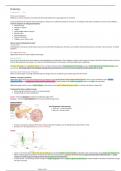College aantekeningen
Diabetes
- Vak
- Instelling
- Boek
Explore the pathophysiology of diabetes, including Type 1 and Type 2 diabetes, gestational diabetes, and other related disorders. Understand the underlying mechanisms, risk factors, and complications associated with each type.
[Meer zien]



